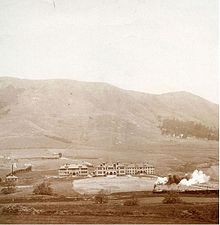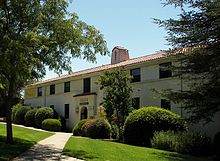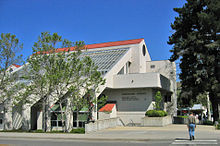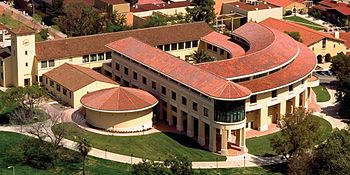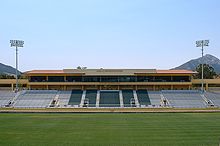- California Polytechnic State University
-
This article is about the university in San Luis Obispo, California. For Cal Poly Pomona in Pomona, California, see California State Polytechnic University, Pomona.
California Polytechnic State University 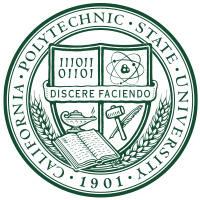
Motto Discere Faciendo (Latin) Motto in English To Learn by Doing Established March 8, 1901 Type Public Land-Grant University Endowment US$ 146.7 million[1] President Jeffrey Armstrong [2] Provost Kathleen Enz Finken Academic staff 1,047 [2009 Fall][3] Admin. staff 1,383 [2009 Fall][3] Students 19,325 [2009 Fall][3] Undergraduates 18,302 [2009 Fall][3] Postgraduates 1,023 [2009 Fall][3] Location San Luis Obispo, California, United States Campus Suburban, 9,678 acres (3,917 ha) Total, 1,321 acres (535 ha) for the Main Campus Colors Green and Gold Athletics NCAA Division I Football Championship Subdivision 20 Varsity Sports Nickname Mustangs Mascot Musty the Mustang Affiliations California State University
Big West Conference
Great West ConferenceWebsite www.calpoly.edu 
See Cal Poly's quickfacts[3] California Polytechnic State University, or Cal Poly, is a public university located in San Luis Obispo, California, United States. The university is one of two polytechnic campuses[4] in the 23-member California State University system.[5]
Comprising six distinct colleges, the university offers 70 undergraduate programs, 26 graduate programs and 6 teaching credentials/certificates.[6] Specifically, the university's engineering, architecture, and agriculture colleges consistently place at the top of United States national academic rankings. In U.S. News & World Report's 2012 America's Best Colleges report, Cal Poly ranked as the #1 Public Master's University in the Western United States for the 19th consecutive year.[7] U.S. News describes the university's admission process as "more selective", yielding an overall acceptance rate of 29% in fall 2010 (freshman acceptance rate: 32%, transfer acceptance rate: 13%). Cal Poly now has more than 140,000 alumni living and working everywhere from New York to Washington D.C. to Wisconsin to Idaho to Hawaii to Hong Kong.[8]
Cal Poly is a member of the American Association of State Colleges and Universities (AASCU) and the National Association of State Universities and Land-Grant Colleges. Cal Poly is known for its "learn by doing" educational philosophy that encourages students to solve real-world problems by combining classroom theory with experiential laboratory exercise. Cal Poly is one of four California State Universities that participate in the Big West Conference in athletics.
Contents
History
Overview
Myron Angel, founder of the California Polytechnic School, San Luis Obispo, CA. January 7, 1899.[9]Cal Poly was established in 1901 when Governor Henry T. Gage signed the California Polytechnic School Bill. The university started out as the California Polytechnic School founded by Myron Angel. The polytechnic school held its first classes on October 1, 1903, offering secondary level courses of study, which took three years to complete. The first incoming class was 20 students.[10] The school continued to grow steadily, except during a period from the mid 1910s to the early 1920s when World War I led to drops in enrollment and drastic budget cuts forced fewer class offerings.
In 1924, Cal Poly was placed under the control of the California State Board of Education. In 1933, the Board of Education changed Cal Poly into a two year technical and vocational school. The institution began to offer Bachelor of Arts degrees in 1940, with the first baccalaureate exercises held in 1942. The school was renamed the California State Polytechnic College in 1947 to better reflect its higher education offerings, and in 1949, a Master of Arts degree in education was added. In 1960, control of Cal Poly and all other state colleges was transferred from the State Board of Education to an independent Board of Trustees, which later became the California State University system.[11]
The college was authorized to offer Master of Science degrees in 1967. From 1967 to 1970, the school’s curriculum was reorganized into different units (such as the School of Science and Math, the School of Agriculture and Natural Resources, and the School of Architecture, which was created in 1968). Cal Poly's FM radio station, KCPR, also began as a senior project in 1968. The state legislature changed the school’s official name again in 1971 to California Polytechnic State University. Since the 1970s, the university has seen steady enrollment growth and the construction of many significant buildings on campus. Cal Poly celebrated its centennial in 2001, and kicked off a $225 million fundraising campaign, the largest fund raising effort ever undertaken in CSU history. The Centennial Campaign raised over $264 million dollars from over 81,000 donors, more than tripling the university’s endowment from $43 million to over $140 million. Cal Poly's endowment was ranked 301 out of 864 colleges and universities in the United States and Canada in 2009.[1] In 1998 the university was referred to as the flagship campus of the California State University system by the chancellor of the CSU.[12]
Relationship with Cal Poly Pomona
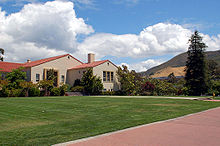 The Dexter Lawn - Cal Poly's unofficial social center and meeting place.[13]
The Dexter Lawn - Cal Poly's unofficial social center and meeting place.[13]
Cal Poly Pomona began as a satellite campus of Cal Poly in 1938 when a completely equipped school and farm were donated by Charles Voorhis and his son Jerry Voorhis of Pasadena, California. The satellite campus was initially called the Voorhis Unit. The W.K. Kellogg Foundation then donated an 812-acre (329 ha) horse ranch in Pomona, California to Cal Poly in 1949. Located about one mile (1.6 km) from the Voorhis campus, the two became known as the Kellogg-Voorhis unit. The Kellogg-Voorhis unit broke off in 1966, becoming the fully independent university, California State Polytechnic University, Pomona. Since 1949, the San Luis Obispo and Pomona universities have cooperated on creating a float for the Rose Parade. Today, the long-running float program still boasts floats designed and constructed entirely by students year-round on both campuses.
1960 Football team plane crash
Main article: Cal Poly football team plane crashOn October 29, 1960, a chartered plane carrying the Cal Poly football team, hours after a loss to Bowling Green State University, crashed on takeoff at the Toledo Express Airport in Toledo, Ohio. 22 of the 48 people on board were killed, including sixteen players.
Female admissions
In 1904, Cal Poly opened as a coeducational school with 40 new male students and 12 new female students. In 1930, Cal Poly banned females from the entire school until 1956 (26 years later) when Cal Poly once again began admitting female students. The university remains coeducational today.
Name
The university's official names are "California Polytechnic State University" and "Cal Poly." When necessary to distinguish between Cal Poly and its former satellite campus, Cal Poly Pomona, the lengthier "Cal Poly at San Luis Obispo" is occasionally used.
As "Cal Poly" is an official name of the university, the athletic department does not sanction appending the name "San Luis Obispo" to the Cal Poly logo.[14]
While Cal Poly is part of the California State University, it is improper to refer to the campus with names such as "CSU San Luis Obispo"[15] or "Cal State SLO",[16][17] because Cal Poly officially retains the name it held before its acquisition by the CSU system.[citation needed]
20th Century Early Leaders (1902-1979)
Leroy Anderson, 1902-1907: Appointed in May 1902, Leroy Anderson was instrumental in establishing the California Polytechnic as the first institution in the state to teach agriculture at the secondary level and the only institution other than the University of California where agriculture was taught. Born in Magee, New York in 1866, Anderson earned his PhD in 1897 at Cornell University. He taught there until 1900, when he came to California to join the agriculture faculty at the University of California. His recommendations for the Polytechnic School, submitted at the request of the board of trustees, resulted in his appointment as director in 1902. Anderson recruited the first faculty. He oversaw the construction of the campus buildings and the equipping of the agricultural and mechanics units. Throughout his five years he was a vigorous promoter of the school, lobbying with the state legislature for support and recruiting students throughout the state.
Leroy Burns Smith, 1908-1914: In 1905, Leroy Burns Smith began his affiliation with Cal Poly as an instructor in English, history and economics. An energetic supporter of the school, he was named vice-director in June 1907 and upon the resignation of Leroy Anderson, became the school's second director in January 1908. Like his predecessor, Smith was a graduate of Cornell University (1901). He came to Cal Poly with educational and administrative experience in the Young Men's Christian Association at the University of Wisconsin and in San Francisco. As the director of the California Polytechnic, Smith continued the campus development and the educational plan begun by Anderson. Smith extended the academic program from three years of study to four, and introduced a series of agricultural and domestic extension courses for men and women on the local farms. At his encouragement and under his advisement, student organizations flourished, and Cal Poly’s Student Association, precursor to the ASI, was formed.
Robert Weir Ryder, 1914-1921: The appointment of Robert Weir Ryder as the third director of the Cal Poly School was, in a sense, an affirmation of the importance of the school's engineering program. A graduate of the University of California, Ryder came to Cal Poly in 1911 as head of the Mechanics Department. Ryder’s administration was marked with numerous innovations to the Cal Poly curriculum, including a college preparatory course, auto mechanics, and a printing course, which was a precursor to today's journalism and graphic communications departments. With the introduction of an academic course, Cal Poly received accreditation by the University of California in 1917. A military training program was introduced at Cal Poly and after World War I, Cal Poly provided vocational training for disabled veterans.
Nicholas Ricciardi, 1921-1924: Nicholas Ricciardi became director of the Cal Poly School on July 1, 1921. On July 30, 1921, an act of legislature restructured the state normal school and vocational school systems. Cal Poly's local board of trustees was disbanded and Ricciardi, now "president," reported to the state superintendent of public instruction. A graduate of the University of California, President Ricciardi brought extensive experience in secondary and vocational education. He had served as director of vocational training for the Oakland school system and as head of the Twelfth District Board for Vocational Training of World War I veterans. At Poly, Ricciardi emphasized "vocational efficiency and efficient citizenship" of students. He introduced vocational testing and guidance into Cal Poly’s educational mission. The Journalism and Graphics Communications departments originated during this period in the new "printing course."
Margaret Chase (Acting), 1924: Margaret Chase, the only woman to head the California Polytechnic, joined its faculty in 1908 as instructor in English and served the institution in a variety of teaching and administrative capacities. Born in Canada, Chase graduated from Dalhousie University and received her M.A. from the University of California. As head of the Academic Department, Chase was instrumental in attaining accreditation from the University of California during the Ryder administration. Having served as Ricciardi's vice-president, Chase was the obvious choice for an interim executive upon his resignation. In a period of fiscal austerity and intense scrutiny of the school's educational mission, Chase provided a sense of continuity and optimism for students and faculty. With the appointment of President Benjamin Crandall, Chase resumed the post of vice president. She also continued as head of the Academic Department and in 1928, was made dean of the Junior College Division. Chase retired from Cal Poly in June 1945. Chase Hall is named in her honor.
Benjamin Ray Crandall, 1924-1933: In Benjamin Crandall, Cal Poly acquired a well-respected educator with teaching and administrative experience at both the secondary and university level. He inherited a somewhat embattled Cal Poly and his tenure was one of constant re-evaluation, reorganization, expansion and retrenchment. With degrees in pedagogy from the University of Wyoming and the University of Denver, and additional graduate training at Cornell and the University of California, Crandall served as superintendent of schools in several western cities prior to becoming a professor of agricultural education at the University of California in 1921. In 1924, he was urged by the State Board of Education and the governor to accept the presidency of Cal Poly. In 1926, the project system, predecessor of the senior projects, was applied in agricultural courses. In 1927, the opening of the two-year Junior College Division foreshadowed Cal Poly's evolution into a university, and a new aeronautics program was added to the Engineering Department. In 1929, as part of a reorganization of the school, enrollment was limited to male students, and by 1933, the college preparatory course was eliminated. The Polytechnic became a vocational institute open only to students over the age of eighteen.
Julian A. McPhee, 1933-1966: A graduate of the University of California, obtaining a B.S. in 1917 and a masters degree in 1928, Julian McPhee first gained experience in agricultural education in the U.C. Agriculture Extension Service and as director of vocational agriculture at El Dorado County High School and Gilroy Union High School. McPhee’s influence in the State Bureau of Agricultural Education helped save the flagging school from being closed by the state. McPhee was instrumental in the reorganization of Cal Poly into a single-sex institute for men over the age of 18. In 1933, McPhee was appointed president of the California Polytechnic and served concurrently as chief of the Bureau of Agricultural Education, California State Department of Education. Then a two-year technical institute, Cal Poly, under President McPhee's leadership, evolved into a four-year college in the California State College system. During WWII, McPhee served as director of California’s War Food Production Training Program. He later served as acting chief of the Bureau of Readjustment Education, assistant executive officer of the State Board of Vocational Education, and director of Vocational Education for the State of California. He was awarded the LL.D. by Armstrong College in 1952. In 1966, after thirty-three years as president of Cal Poly, Julian A. McPhee retired.
Dale W. Andrews (acting), 1966-1967: Dale W. Andrews received his B.A. from the University of California, Davis in 1941 and his M.A. in agricultural education at Cal Poly in 1952. Andrews joined the Cal Poly faculty in 1950 as an instructor in agricultural education. He is credited with establishing the annual Poly Royal buttons. In 1960, Andrews was named Special Educational Services coordinator by President Julian McPhee. In 1966, he was appointed vice-president and then acting president when President McPhee retired. He was named executive vice-president in 1973. In 1979, he was once again named acting president following the retirement of President Robert E. Kennedy.
Robert E. Kennedy, 1967-1979: Robert E. Kennedy received his B.A. from San Diego State College in 1938, his M.A. in journalism from Stanford University in 1950, and his Ph.D. in education administration from Claremont Graduate School (now Claremont Graduate University) in 1966. Kennedy joined the Cal Poly faculty in 1940 as a journalism instructor. He served as advisor to student publications, and during WWII, with the arrival of U.S. Naval training programs on the Cal Poly campus, instructed cadets in communications. In 1946, Kennedy became head of the Journalism Dept., to which title he added public relations director in 1949. He was assistant to President Julian McPhee from 1950 to 1957; dean of the Arts and Sciences Division from 1957 to 1959; and vice president of Cal Poly from 1959 to 1967. Following the retirement of President McPhee, Kennedy was appointed president. In 1972, under President Kennedy's leadership, California Polytechnic State College was officially designated California Polytechnic State University. During his long tenure as faculty and administrator at Cal Poly, Robert Kennedy represented the college on numerous state and national education councils, including the Chancellor's Council of Presidents and the American Association of State Colleges and Universities (AASCU). For the AASCU he served as a member of the board of directors, a representative to the Education Commission of the States and a member of AASCU committees on agriculture, public relations, and state relations. In 1978, in honor of his long and dedicated service to Cal Poly, the CSUC Trustees voted to name the new Cal Poly library "The Robert E. Kennedy Library."
Warren J. Baker 1979-2010. Holding BS and MS degrees in civil engineering from the University of Notre Dame, Baker received his doctorate in geotechnical engineering from the University of New Mexico.
Under Baker’s leadership, Cal Poly consistently earned national recognition for academic excellence including 17 year in a row as the best public-master's university in the West by U.S. News & World Report. This is largely due to Cal Poly's learn by doing educational methodology that encourages students to solve real-world problems by combining classroom theory with experiential laboratory exercise. Also during Baker’s tenure, admission to Cal Poly became increasingly competitive. Freshmen SAT scores and grade-point averages steadily increased and as a result, applications to the university increased nearly fivefold over the past 30 years making Cal Poly one of the most selective public universities in the nation.
Applied research programs also expanded over the Baker years. Among the new centers and institutes for applied research established since 1979 were the Irrigation Training and Research Center, the Environmental Biotechnology Institute, the Dairy Products Technology Center, the Collaborative Agent Design (CAD) Research Center, and the Brock Institute for Agricultural Communication. Baker also oversaw an aggressive upgrade and expansion of campus buildings and facilities that approached $1 billion over his 30 years, thanks to investment from a variety of public and private sources.
Jeffrey D. Armstrong, 2011 – present: Jeffrey D. Armstrong currently serves as Cal Poly's president. President Armstrong received his bachelor's degree in agriculture from Murray State University. He received both his master's and doctorate in physiology and endocrinology from North Carolina State University. Armstrong joined the Cal Poly campus in 2011 after tenure at North Carolina State University (faculty), Purdue University (Head of the Department of Animal Sciences) and Michigan State University (Dean of the College of Agriculture and Natural Resources).
Administrative Organization
Four Administrative Divisions
The university is organized administratively into four divisions: Academic Affairs, Student Affairs, Administration and Finance, and University Advancement. The academic division is organized into six colleges, each with its own dean. Academic Affairs also includes the Library, Research and Graduate Programs, and Information Technology Services.
Cal Poly Corporation
The Cal Poly Corporation is a public-benefit, nonprofit corporation and university auxiliary. It provides commercial services, fiscal services, and key support services to assist and promote the educational mission of Cal Poly and the California State University System (CSU). The Corporation engages only in those activities ancillary to state operation that are requested by Cal Poly’s President and approved by the CSU. The corporation was founded in 1941 and was known as the Cal Poly Foundation until February 1, 2006.
Cal Poly Foundation
The Cal Poly Foundation is an auxiliary organization and IRC 501(c)(3) public charity that accepts and administers tax deductible gifts to the university. The Cal Poly Foundation leads campus philanthropic activity by supporting fundraising activities and investing and managing the campus endowments.
Cal Poly Housing Corporation
The Cal Poly Housing Corporation (CPHC) is also a public-benefit, nonprofit corporation and university auxiliary. The CPHC provides the university with certain services and facilities that by law cannot be financially supported by the state government. Its purpose is to develop, provide, and maintain affordable housing for faculty and staff consistent with the teaching, research, and community service mission of the university.
Cal Poly Continuing Education
The Cal Poly Continuing Education provides access to degree, certificate, and professional development programs and services of the university to the citizens of San Luis Obispo, Santa Barbara, and Monterey Counties and through distance learning technologies to students across the country.
Associated Students Inc.
The Associated Students Inc., (ASI) is a 501(c)(3) nonprofit corporation owned and operated by Cal Poly student leaders. ASI has an annual operating budget in excess of $12 million. ASI provides cocurricular experiences for students, faculty, and staff, including events, speakers, concerts, intramural sports, fitness programs, aquatics, outdoor adventure trips, craft center enrichment courses, and child development. ASI manages the University Union, Recreation Center, Sports Complex, and Children’s Center, totalling more than 450,000 square feet (42,000 m2) of campus facilities.
The Alumni Association
The Alumni Association keeps in touch with many of the 150,000 students who have attended Cal Poly through a variety of alumni functions, both educational and social, on and off campus, throughout California, and across the nation.
Campus
Cal Poly is the second largest land-holding university in California, with holdings totaling 9,678 acres (3,917 ha) (2nd only to UC Berkeley and 1st in the CSU system).[3] Part of the Cal Poly property is the Swanton Pacific Ranch, a 3,200-acre (1,300 ha) ranch located in Santa Cruz County, California, outside the town of Davenport. The ranch provides educational and research opportunities, encompasses rangeland, livestock, and forestry operations for the College of Agriculture, Food, and Environmental sciences, and fosters Cal Poly’s teaching philosophy of “Learn by Doing” with emphasis on sustainable management of agricultural practices.
Expansion
The Cal Poly Master Plan calls to increase student population from approximately 17,000 students to 20,000 students by the year 2020–2021. To maintain the university's "Learn by Doing" philosophy and low class sizes, the master plan calls for an increase in classrooms, laboratories, and professors.
Current construction
- The Center for Science and Mathematics
- Will replace aging "spider" Science Building 52, built in the 1950s, with a new 197,000-square-foot (18,300 m2) structure. The $132 million, six-story building was made possible by voter-approved state education bonds and $20 million in private donations to Cal Poly. It is currently under construction and set to open in 2013. The center will add new laboratories, classrooms, and study spaces and house the university's Environmental Biotechnology Institute and its Western Coatings Technology Center. It is planned to be the largest and most technologically advanced structure on campus once completed. In the space between the remaining wings of the old "Spider Building" and the new Center will be Centennial Park, a landscaped central green.[18]
- Recreation Center Expansion
- Will expand the Recreation center and triple its usable size. Two new gym rooms, additional leisure pool, synthetic turf for sports complete fields, triple the size of exercise and weight training rooms (from 7,000 sq ft (650 m2) to 21,000 sq ft), and a multi-activity center are planned additions to the recreation center. (Student Vote passed on 28 Feb 08. Construction began Fall 2008.) The expanded Recreation Center will be open for student use in early 2012.
Commuting
Campus parking is limited. In its most recent survey of available parking spaces on campus, the Cal Poly University Police reported 2,615 general purpose parking spaces, 1,635 dorm resident spaces, and 6,621 total spaces.[19] In its facilities Master Plan, the university admits that while more parking spots will be added, the actual ratio of parking to students will decrease since enrollment is expected to increase sharply.[20] To resolve the disparity, the Master Plan calls on the university to reduce the demand for individual vehicle parking. As part of that plan, the university has constructed additional dorms and has tried to make campus life more enjoyable. However, many students would prefer not to live on campus for a variety of reasons, including alcohol restrictions and a mandatory meal plan for Freshmen. Recently, the school launched a public information campaign called "Options", which seeks to educate students on commuting alternatives, though it is not clear that the campaign has had any effect. Additionally, the campus police discourage alternate forms of transportation such as skateboarding and rollerblading by prohibiting them on campus.[21] Recent increases in parking costs and gas prices have caused a massive increase in the use of bicycles and buses.[citation needed]
Bicycle racks are available throughout the campus, but the off-campus student population is mostly centered in areas either close enough to walk or areas judged to be too far to ride a bicycle.[citation needed] The city's SLO Transit bus system provides service to and from campus. Since the buses are partially subsidized by student tuition, Cal Poly students can ride for free. Bus service throughout the county is provided by SLO Regional Transit Authority. Discounted passes are available to the Cal Poly community.
360° panorama taken from the top of Poly Canyon; the main Cal Poly campus and agricultural area can be seen below. Cal Poly owns more land than any other California State university. There are 9,678 acres (3,917 ha) in total. The lands are used for student education, mainly agricultural education. The lands include the main campus, two nearby agricultural lands and two properties in Santa Cruz County.
Academics
Colleges
The university currently offers bachelor's degrees, master's degrees, and one joint-doctorate in six colleges:
- College of Agriculture, Food and Environmental Sciences
- College of Architecture and Environmental Design
- Orfalea College of Business
- College of Engineering
- College of Liberal Arts
- College of Science and Mathematics
Ranking
According to U.S. News & World Report's 2012 America's Best Colleges report, Cal Poly is ranked 1st in the Western United States for regional public schools whose highest degree is a Master's for the 19th straight year.[22] The College of Engineering was tied for the #5 ranking for undergraduate engineering schools in the US whose highest degree is a Master's.[23] Cal Poly’s Orfalea College of Business once again has been named to Business Week magazine’s list of the nation’s top undergraduate business colleges, moving up to No. 64 on the 2010 list.[24]
In 2010, Forbes' Magazine found Cal Poly #27 out of the nation's 100 best public universities and #177 out of the 600 best private and public colleges and universities in America. Cal Poly moved up on the overall list from #201 in 2009, and #369 in the 2008 rankings.[25]
Demographics of student body [26] Undergraduate African American 0.9% Asian American 10.7% White American 65.2% Hispanic American 11.8% Hawaiian/Pacific Islander 0.1% Native American 0.6% Multi-Racial 2.2% Non-resident/Alien 1.0% Ethnicity unreported/unknown 7.7% Among public schools whose highest degree is a master's, specific engineering programs were ranked (overall includes both private and public universities):
- Electrical Engineering: #1 (#2 overall)[27]
- Computer Engineering: #1 (Tied #3 overall)[28]
- Mechanical Engineering: #1 (Tied #2 overall)[29]
- Industrial Engineering: #2 (#2 overall)[30]
- Aerospace Engineering: #3 (#5 overall)[31]
- Civil Engineering: #2 (Tied #5 overall)[32]
In the 2009 edition of "America's Best Architecture & Design Schools" published by the leading architecture and design journal "DesignIntelligence," Cal Poly was the #3 undergraduate architecture school in the nation. The landscape architecture program was ranked #10.[33]
Cal Poly’s graduate program in City and Regional Planning ranked #1 in the "Planetizen" 2009 Guide to Graduate Urban Planning Programs, in the US whose highest degree is a Master's.[34]
In 2009, the magazine "Diverse Issues in Higher Education" placed Cal Poly among the top 10 of its “Top 100 Degree Producers 2009” ranking. This places the university in the top 10 schools in the nation in granting degrees to Hispanic, Asian and other minority students in agriculture, architecture and engineering.[35]
Alumni of Cal Poly average the third-highest salaries of all public university graduates in the United States according to a Forbes.com ranking.[36] Cal Poly outperformed all public universities in the nation other than U.C. Berkeley and the University of Virginia. The median annual earnings for Cal Poly graduates with 10–20 years career experience is $101,000, with the top 10% earning more than $178,000. The U.C. Berkeley and University of Virginia median/top 10% performances are $112,000/$201,000 and $103,000/$215,000 respectively.
Admissions
Fall Freshman Statistics[37][38][39][39]
2011 2010 2009 2008 2007 Applicants 32,995 33,626 31,496 33,345 30,155 Admits 12,311 10,918 11,740 11,117 13,432 % Admitted 37.31 32.47 37.27 33.34 44.54 Cal Poly's admissions process is "more selective" according to US News.[40] For fall 2010, Cal Poly accepted 10,918 freshman applicants out of a total 33,626 freshman applicants, yielding a 32% freshman acceptance rate.[41] Accepted freshman applicants had an average high school GPA of 3.90[42] and an average SAT Reasoning Test score of 1292 (out of a possible 1600, based only on reading and math scores).[41] For transfer acceptance, Cal Poly accepted 922 transfer applicants out of a total 7365, yielding a 13% acceptance rate.[41] Accepted transfer applicants had an average university GPA of 3.41.[41] The combined figures yield an overall, fall 2010, acceptance rate of 29%.[41]
Cal Poly requires students to declare a major when applying for admission, and the university then admits the most competitive applicants within each major. Because of this, certain Cal Poly majors set higher admission standards than do other majors. To prevent students from applying for an easy-to-get-into major and transferring to another major, Cal Poly makes it difficult to change majors. Each major has adopted a specific change of major plan which includes required classes to be taken while maintaining a certain GPA (usually between 2.5-2.75) in order to be considered as a transfer candidate. Students within the college (i.e. College of Engineering, College of Business) are often granted priority over outside transfers and often transfers from other universities. While many hear it is difficult to change majors, those who are committed to their newly desired major find little trouble or hidden steps in the transfers process. Cal Poly prides itself on students taking courses within their major right away in their freshman year to advance the knowledge that they walk away with as graduates. However, in some cases, students wishing to change majors completely transfer to other universities.
Tuition
Due to the state-wide fee increase, fall 2009 fees for the average student will be $2,066 per quarter.[43] The winter 2008 fees for the average student were $1,681 per quarter.[44] The spring 2002 fees for the average student were $760 per quarter.
These quarterly tuitions are for Colleges of Agriculture, Business, Engineering, Architecture & Environmental Design, and Science & Math. Liberal Arts majors will pay less, at $1966 per quarter.
Endowment
Cal Poly’s endowment more than tripled during its Centennial Campaign from US$43.1 million to US$140.1 million. Growth is attributed to gifts and prudent stewardship. However, since 2007, the university's endowment has lost over 30% of its value (about $56 million) going from $181.7 million in 2007.[45] to $125.4 million in 2009[46]
Student life
Residence halls
 Residential halls
Residential halls
There are five distinct groups of residence halls on the Cal Poly campus. The five North Mountain halls, constructed in the 1950s, are the oldest on campus still used for residential purposes. The six "red-brick" halls were completed shortly afterward in 1959.[47] The Sierra Madre and Yosemite halls were finished by 1968, and the Cerro Vista Apartments were completed in 2003. The Poly Canyon Village housing complex, with a similar style as the Cerro Vista apartments, opened in Fall 2008.
Each of the residence halls represent a different living community on campus. The six red-brick halls are the Living-Learning Program halls for the different colleges of Cal Poly. The five North Mountain halls are organizationally a part of the engineering Living-Learning Program. The Sierra Madre and Yosemite halls are the First-Year Connection Program halls and focus on freshman-oriented transition programs. All buildings house students of all majors. The Cerro Vista Apartments is the Transitions community for first-year and second-year students. Poly Canyon Village is the Sophomore Success Program community, which is open to primarily to sophomores, but also juniors and seniors, and helps students transition into independent living. The total on-campus population is 6,500, making it the largest student housing program in the California State University System.[48]
Greek life
Since 1949, Greek organizations have been present at Cal Poly. The Greek community consists of three governing councils at Cal Poly: United Sorority and Fraternity Council (USFC), Interfraternity Council (IFC), and Panhellenic Association (PHA).[49]
There are currently:
10 USFC Fraternities/Sororities: Alpha Kappa Delta Phi, Chi Delta Theta, Gamma Zeta Alpha, Lambda Phi Epsilon, Lambda Sigma Gamma, Lambda Theta Alpha, Lambda Theta Phi, Nu Alpha Kappa, Omega Xi Delta, Sigma Omega Nu17 IFC Fraternities: Alpha Epsilon Pi, Alpha Gamma Rho, Beta Theta Pi, Delta Chi, Delta Lambda Phi, Delta Sigma Phi, Delta Upsilon, Lambda Chi Alpha, Phi Delta Theta, Phi Kappa Psi, Phi Sigma Kappa, Pi Kappa Alpha, Sigma Nu, Sigma Pi, Tau Kappa Epsilon, Theta Chi, Zeta Beta Tau,
7 Panhellenic Sororities: Alpha Chi Omega, Alpha Omicron Pi, Alpha Phi, Chi Omega, Gamma Phi Beta, Kappa Alpha Theta, Sigma Kappa,
1 Panhellenic Interest Group: Alpha EpsilonFraternity for College Band Members: Kappa Kappa Psi
Week of Welcome orientation program
Also known as WOW, the Week of Welcome program serves as a volunteer-based orientation program for new students during the week prior to the beginning of the school year in September. Its purpose is to introduce students to the campus and the community and prepare them for a successful college career. New students are placed in a group of about 10–20 other new students led by two current Cal Poly student Orientation Leaders. The WOW groups participate in an array of orientation events in addition to activities both on- and off-campus. In 2010, the awareness section of the program won the 2010 National Orientation Directors Association (NODAC) Media & Publications Showcase Award in the Emerging Technologies. The awareness section was entirely developed by student volunteers. The program started in 1957 and is now the largest volunteer orientation program in the nation.[50][51]
Athletics
See also: Cal Poly Mustangs football and Mustang BandCal Poly fields 20 varsity sports. The school's mascot is Musty the Mustang. Sports teams participate in the NCAA's Division I. Cal Poly athletics generally compete in the Big West Conference, with football and wrestling being the exception. Cal Poly's wrestling team is a member of the PAC-10 Conference. Prior to joining Division I in the mid 90s, the school won 35 national championships.[52] Football plays in the Great West Football Conference. Their football team is notable for being the first Great West Football Conference participant in the Football Championship Subdivision playoffs. The football team plays rival UC Davis in the annual Battle for the Golden Horseshoe. The Mustang Maniacs are Cal Poly's spirit group. They support the team both away and at home. The Mustang basketball team had its most successful year in 2007, when the team came within one win in the Big West basketball tournament of getting into the NCAA basketball tournament
One of the school's best programs, in recent years and in the 1980s, is the women's volleyball team. On November 19, 2007 the team captured its second straight Big West Title by posting a 15-1 conference record and a 23-8 record overall. The program made it to the third round of the playoffs for the first time since 1985 before losing to Stanford in the Sweet 16. The team also went 23-6 in 2006.
In addition to the women's volleyball team, the men's cross country team has finished in the top 25 in the nation four of the past five years. In 2009, Coach Mark Conover and his men's squad captured their seventh straight Big West Title. Their last national placing was in 2008, when they finished 23rd at the National Cross Country Championships in Terre Haute, IN.
The Cal Poly Mustangs men's soccer team has also had success in recent years. In 2008, Coach Paul Holocher led his team to a 3rd place in the Big West and a spot in the NCAA Division I tournament. They went on to beat UCLA and ended up losing to UC Irvine in the 2nd round. Cal Poly Men's Soccer has a rivalry with UCSB Men's Soccer, being 2 notable California central coast schools and having successful soccer programs, in 2009 the rivalry was one of two televised collegiate soccer games.
Blue-Green Rivalry - A Series for Sustainability
The Blue-Green Rivalry is based on Gauchos and Mustangs competing in 16 sports. Each winner will receive one point per win (regular season) with two points being awarded to series winner in baseball and softball. The overall winner will be announced each spring.
The creative angle of using games to promote campuses' sustainability and recycling efforts is first of its kind in college athletes. Both Cal Poly and UCSB plan expanding marketing of the innovative rivalry series to include sponsor messages, recycling challenges, and additional promotional platforms in upcoming years.
Cal Poly and UCSB have a combined 40,000 student population and almost 5,000 faculty/staff and reach approximately a half million fans in the Central Coast region each year through athletics.
Wrestling Program
The wrestling program at Cal Poly competes as a member of the Pacific-12 Conference (Pac-12) which is traditionally one of the strongest conferences in college wrestling. Cal Poly has had two wrestlers (Tom Kline & Mark DiGirolamo) win the NCAA Wrestling Championship and 44 wrestlers earn All-American honors. In addition to the program's success at the NCAA Championshions the program has crowned one champion at the National Collegiate Open Wrestling Championship.
Softball Program
Main article: Cal Poly SoftballThe Cal Poly softball team is a part of the Big West Conference which includes Cal State Fullerton, Cal State Northridge, UC Santa Barbara, UC Riverside, UC Davis, and University of Pacific.
Notable athletes
- Mike Amos, WR - Class of 1974 - Kodak All-American
- Ramses Barden, WR - Class of 2009 - All-American Wide Receiver - Currently playing with the New York Giants
- Bobby Beathard, Quarterback on 1960 Cal Poly football team; former NFL General Manager of San Diego Chargers and Washington Redskins
- Jordan Beck, LB - Class of 2005 - All American Linebacker - Buck Buchannan Award winner
- John Orton, catcher - Class of 1987 - First round draft pick of the California Angels, major league debut 1989
- Courtney Brown, DB - Class of 2006 - Currently an NFL Free Agent
- Stephanie Brown Trafton - Class of 2003 - Gold medalist in women's discus throw at the 2008 Summer Olympics
- Kevin Correia, pitcher - Class of 2002 - Currently playing with the Pittsburgh Pirates
- Grant Desme, center fielder – Big West Conference Player of the Year.
- Casey Fien, Pitcher - Currently playing for the Detroit Tigers
- Chris Gocong, LB - Class of 2006 - All American Defensive End - Buck Buchannan Award winner - Currently playing with the Cleveland Browns
- Mel Kaufman, LB - Class of 1981 - Winner of two Super Bowl Rings, Captain of the Washington Redskins
- Mike Krukow, pitcher - Class of 1973 - National League All-Star; Emmy-award-winning broadcaster for the San Francisco Giants
- Chuck Liddell,[53] Mixed Martial Arts Fighter - Class of 1995 - Ultimate Fighting Championship Light Heavyweight Champion of the World 2005–2007
- John Madden, head coach - Class of 1959 - Oakland Raiders - NFL Hall of Fame
- Gina Ostini Miles, United States Equestrian Team member - US Individual Olympic Silver Medalist - 2008 Beijing Olympics in 3-Day Eventing[54]
- Bud Norris, Pitcher - Currently playing for the Houston Astros
- Garrett Olson, pitcher - Class of 2005 - Currently playing with the Seattle Mariners
- Anton Peterlin, All-Big West soccer player - Currently playing with Plymouth Argyle F.C.
- Loren Roberts, professional golfer - Class of 1977 (left in 1975) - Currently on Champions Tour
- Kyle Shotwell, LB - Class of 2007 - All American Linebacker, Buck Buchannan award winner as nation's top defensive player at Div. I-AA]
- Ozzie Smith, shortstop - Class of 1977 - St. Louis Cardinals- MLB Hall of Fame
- Ted Tollner, QB - Class of 1962 - Oakland Raiders
Notable Senior Projects
All students at Cal Poly are required to complete a senior project. The senior project is intended to be a capstone experience for students receiving a baccalaureate degree to integrates theory and application from across a student's undergraduate educational experiences.[55] The senior project consists of one or more of the following: a design or construction experience, an experiment, a self-guided study or research project, a presentation, a report based on internship, co-op, or service learning experience, and/ora public portfolio display or performance. [56] Famous senior projects include:
- Jamba Juice, originally founded as "Juice Club."[57]
- Punch'd, an electronic customer loyalty program acquired by Google in July 2011.[58]
Notable alumni
Main article: List of California Polytechnic State University alumniSee also
- California State Polytechnic University, Pomona (Cal Poly Pomona)
- California Master Plan for Higher Education
Notes
- ^ a b As of August 31, 2010. "U.S. and Canadian Institutions Listed by Fiscal Year 2010 Endowment Market Value and Percentage Change in Endowment Market Value from FY 2009 to FY 2010" (PDF). 2010 NACUBO-Commonfund Study of Endowments. National Association of College and University Business Officers. https://docs.google.com/viewer?url=http%3A%2F%2Fwww.nacubo.org%2FDocuments%2Fresearch%2F2010NCSE_Public_Tables_Endowment_Market_Values_Final.pdf. Retrieved April 11, 2011.
- ^ "CSU Trustees Appoint Jeffrey Armstrong as New President of Cal Poly". http://www.calpolynews.calpoly.edu/news_releases/2010/December/armstrong_president.html. Retrieved December 15, 2010.
- ^ a b c d e f g http://calpolynews.calpoly.edu/quickfacts.html
- ^ Gerth 2010, p. 3.
- ^ "Campus Homepages". California State University. http://www.calstate.edu/search_find/campus.shtml. Retrieved 2010-02-01.
- ^ Calpoly.edu
- ^ {{cite web |url=http://calpolynews.calpoly.edu/news_releases/2011/September/news.html
- ^ "About Cal Poly". Cal Poly. http://www.calpoly.edu/aboutcp.html. Retrieved 2011-03-27.
- ^ Pflueger 1999, p. 15.
- ^ "Highlights in the History of Cal Poly". Cal Poly. http://lib.calpoly.edu/universityarchives/history/timeline/. Retrieved 2007-02-10.
- ^ 1981-83 Catalog. San Luis Obispo, CA: California Polytechnic State University. 1981.
- ^ "ASI". Cal Poly. http://www.asi.calpoly.edu/admin/img/updocument/BODMinutes99-01_09-30-98.pdf. Retrieved 2007-02-10.
- ^ Kabalka, Kabalka, Christian, & Pults, Cal Poly Land: Dexter Lawn, http://polyland.calpoly.edu/topics/history/studentsites/2006a/Index.htm, retrieved 17 August 2011
- ^ "CAL POLY ATHLETICS BRAND AND GRAPHICS GUIDELINES" (PDF). California Polytechnic State University. p. 3. http://www.gopoly.com/images/uploads/pages/File/Branding%20Guidelines/CalPolystyleguide070708.pdf. Retrieved 2011-04-06.
- ^ Calstate.edu
- ^ Humboldt.edu
- ^ UCSF.edu
- ^ Calpoly.edu
- ^ Parking Lot Survey Cal Poly University Policy Department, January 20, 2006
- ^ Cal Poly Campus Master Plan Cal Poly Facilities Planning and Capital Projects, March 21, 2001
- ^ Calpoly.edu, UPD Skateboarding
- ^ "Cal Poly is Best in the West for the 19th Year in U.S. News Rankings". Cal Poly. http://calpolynews.calpoly.edu/news_releases/2011/September/news.html. Retrieved 2011-09-21.
- ^ "Best Colleges Specialty Rankings: Best Undergraduate Engineering Programs". U.S. News & World Report. http://colleges.usnews.rankingsandreviews.com/best-colleges/spec-engineering. Retrieved 2009-08-22.
- ^ "Top Undergraduate Business Programs 2010". http://www.businessweek.com/interactive_reports/bschools_undergraduate_10rankings.html.
- ^ "Cal Poly on Forbes Magazine’s List of America’s Best Colleges". Cal Poly. http://www.calpolynews.calpoly.edu/news_releases/2009/August/Forbes.html. Retrieved 2009-08-22.
- ^ Fall 2009 Factbook Retrieved on January 30, 2009
- ^ "Best Colleges Specialty Rankings: Undergraduate Engineering Specialties: Electrical / Electronic / Communications Rank". U.S. News & World Report. http://colleges.usnews.rankingsandreviews.com/best-colleges/spec-electrical. Retrieved 2009-08-22.
- ^ "Best Colleges Specialty Rankings: Undergraduate Engineering Specialties: Computer". U.S. News & World Report. http://colleges.usnews.rankingsandreviews.com/best-colleges/spec-computer. Retrieved 2009-08-22.
- ^ "Best Colleges Specialty Rankings: Undergraduate Engineering Specialties: Mechanical". U.S. News & World Report. http://colleges.usnews.rankingsandreviews.com/best-colleges/spec-mechanical. Retrieved 2009-08-22.
- ^ "Best Colleges Specialty Rankings: Undergraduate Engineering Specialties: Industrial / Manufacturing". U.S. News & World Report. http://colleges.usnews.rankingsandreviews.com/best-colleges/spec-industrial. Retrieved 2009-08-22.
- ^ "Best Colleges Specialty Rankings: Undergraduate Engineering Specialties: Aerospace / Aeronautical / Astronautical". U.S. News & World Report. http://colleges.usnews.rankingsandreviews.com/best-colleges/spec-aero. Retrieved 2009-08-22.
- ^ "Best Colleges Specialty Rankings: Undergraduate Engineering Specialties: Civil". U.S. News & World Report. http://colleges.usnews.rankingsandreviews.com/best-colleges/spec-civil. Retrieved 2009-08-22.
- ^ "Cal Poly College of Architecture Ranks Third in Nation". Cal Poly. http://calpolynews.calpoly.edu/news_releases/2009/January/CAED-Rankings.html. Retrieved 2009-08-22.
- ^ "Cal Poly Master’s Program is Top of its Class". Cal Poly. http://www.calpolynews.calpoly.edu/news_releases/2008/August/caed_crp.html. Retrieved 2008-09-09.
- ^ "Cal Poly Ranks in Top 10 Nationally in Degrees to Minority Students". Cal Poly. http://calpolynews.calpoly.edu/news_releases/2009/August/diverse.html. Retrieved 2009-08-22.
- ^ "Forbes.com Ranks Cal Poly No. 3 Public in National Compensation Study". Cal Poly. http://www.calpolynews.calpoly.edu/news_releases/2008/August/forbes_ranking.html. Retrieved 2008-09-09.
- ^ [1]. Cal Poly admissions, Fall 2011.
- ^ [2]. Cal Poly Profile, Fall 2009.
- ^ a b [3]. Cal Poly Profile, Fall 2010. 7/9/11
- ^ http://colleges.usnews.rankingsandreviews.com/best-colleges/san-luis-obispo-ca/cal-poly-1143/@@Admissions_overview.html
- ^ a b c d e "Cal Poly, the Profile" (PDF). Cal Poly. http://www.ess.calpoly.edu/_admiss/Pdf/Profile10_51910.pdf. Retrieved 2010-05-19.
- ^ Calpoly.edu
- ^ Calpoly.edu
- ^ Cal Poly Student Accounts, Fee Payment Policy
- ^ Nacubo.org
- ^ Calply.edu
- ^ "DigitalCommons@CalPoly - Division of Architecture Department of Public Works: South Mountain Residence Halls - Buildings 105-110". Cal Poly. http://digitalcommons.calpoly.edu/fpcp_mp/58/. Retrieved 2008-09-09.
- ^ "Poly Canyon Village Grand Opening Set for Aug. 19". Cal Poly. http://www.calpolynews.calpoly.edu/news_releases/2008/August/pcv_grand_open.html. Retrieved 2008-09-09.
- ^ "Greek Life". Cal Poly. http://www.studentlife.calpoly.edu/greek/index.asp. Retrieved 2009-08-22.
- ^ "What WOW is to New Students?". Cal Poly. http://studentlife.calpoly.edu/orientation/wow/newstudents/index.asp. Retrieved 2010-02-13.
- ^ "WOW - Week of Welcome". Cal Poly. http://admissions.calpoly.edu/undergrad/reg_wow.htm. Retrieved 2010-02-13.
- ^ "The Official Website of Cal Poly Athletics". http://gopoly.com/index.php?p=facilities. Retrieved 2007-04-07.
- ^ "Learning From UFC Champion, Chuck Liddell". http://www.extremeprosports.com/full_contact_fighting/chuck_liddell.html. Retrieved 26 November 2008.
- ^ "Gine Ostini Miles biography at TeamUSA.org". U.S. Olympic Committee. 2011. http://equestrian.teamusa.org/athletes/gina-miles. Retrieved September 12, 2011.
- ^ Cal Poly Academic Programs: "Senior Project". Last accessed October 8, 2011.
- ^ Cal Poly Academic Programs: "Senior Project". Last accessed October 8, 2011.
- ^ Blended Bliss, Cal Poly Magazine (Summer 2007), accessed October 18, 2011.
- ^ Collaboration Packs a Punch at Poly: Google Acquires Punchd, a Cal Poly Senior Project, Cal Poly Magazine (Fall 2011), accessed October 8, 2011.
Sources
- Gerth, Donald (2010), The People's University: A History of the California State University, Univers
- Pflueger, Donald (1999) [1991], California State Polytechnic University, Pomona: A Legacy and a Mission, Spokane, Washington: Arthur H. Clark Company, ISBN 0-96228221, OCLC 43853707ity of California, Institute of Governmental Studies, ISBN 0877724350, http://books.google.com/books?id=v4J-QwAACAAJ&dq=0877724350&cd=1
External links
California Polytechnic State University, San Luis Obispo Colleges College of Agriculture, Food and Environmental Sciences · College of Architecture and Environmental Design · Orfalea College of Business · College of Education · College of Engineering · College of Liberal Arts · College of Science and MathematicsStudent Life The "P" · Cal Poly Universities Rose Float · Mustang Daily · KCPR · ASI · Mustang Band · Week of Welcome · Open House · Homecoming · AlumniCampus Facilities Performing Arts Center · student housing · Poly Canyon Village · Alex G. Spanos Stadium · Robin Baggett Stadium · Robert E. Kennedy Library · Center for Coastal Marine Sciences · Leaning Pine Arboretum · Cheda RanchAthletics Mustang Athletics · Mustang Maniacs · Battle for the Golden Horseshoe · Mercy Bowl · Football · Men's Basketball · Men's Soccer · BaseballThe California State University
Est. 1857Campuses Bakersfield • Channel Islands • Chico • Dominguez Hills • East Bay • Fresno • Fullerton • Humboldt • Long Beach • Los Angeles • Maritime • Monterey Bay • Northridge • Pomona • Sacramento • San Bernardino • San Diego • San Francisco • San Jose • San Luis Obispo • San Marcos • Sonoma • Stanislaus
Research and academics History Vox Veritas VitaBig West Conference Current members Cal Poly SLO Mustangs • Cal State Fullerton Titans • Cal State Northridge Matadors • Long Beach State 49ers • Pacific Tigers • UC Davis Aggies • UC Irvine Anteaters • UC Riverside Highlanders • UC Santa Barbara Gauchos
Future members Hawai'i Rainbow Warriors / Rainbow Wahine (2012)
Great West Conference Full members Chicago State Cougars • Houston Baptist Huskies • NJIT Highlanders • North Dakota Fighting Sioux (leaving in 2012) • Texas–Pan American Broncs • Utah Valley Wolverines
Football associate
membersCal Poly Mustangs (leaving in 2012) • Southern Utah Thunderbirds (leaving in 2012) • South Dakota Coyotes (leaving in 2012) • UC Davis Aggies (leaving in 2012)
Olympic sports
associate membersCSU Bakersfield Roadrunners • Delaware State Hornets • Howard Bison • UN-Omaha Mavericks (leaving in 2012) • NYIT Bears • Northern Colorado Bears • Seattle Redhawks (leaving in 2012) • South Carolina State Bulldogs
Coordinates: 35°18′06″N 120°39′35.35″W / 35.30167°N 120.6598194°WCategories:- California Polytechnic State University, San Luis Obispo
- Universities and colleges in San Luis Obispo County, California
- San Luis Obispo, California
- Schools accredited by the Western Association of Schools and Colleges
- Association of Public and Land-Grant Universities
- American Association of State Colleges and Universities
- Educational institutions established in 1901
Wikimedia Foundation. 2010.

